Editors: Sit down somewhere comfortable and take a little trip through the strange world of Tom Francis. The views stated below are not necessarily those of the editors, since all of the answers and even the questions are the sole creation and responsibility of one, T.F.
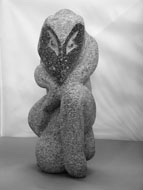
LT: Our featured artist this issue is Tom Francis. Tom, who are you?
TF: Rumors and innuendo. That should be "alleged" artist, those charges haven't been proven. What is this, Twenty Questions?
LT: Thirty-two actually. What is your life history as it relates to being an artist?
TF: Alleged.
LT: Alleged artist.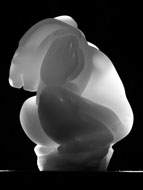
TF: A sad story really... From grade school through high school, it was make believe, and then pretend, then finally fantasy. So for college I went into theater. From theater to bonsai, bonsai to sculpture. I see it as a straight line.
LT: The question could be asked, why did you become an alleged artist?
TF: And the truest answer would be, "I don't know." Crippled in other ways, I guess.
LT: What key life experiences affected your direction in art?
TF: Are all these questions the same, just asked in different ways?
LT: Yeah, pretty much.
TF: OK then. It all started with potty training...
LT: Can you elaborate?
TF: Did I mention theater? That’s a lot like potty training.
LT: OK, next question. Who or what has influenced your art form?
TF: Pop surrealism.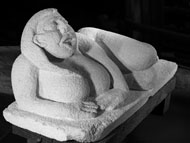
LT: Why is art important to you?
TF: Like the bumper sticker says: Art Saves Lives. Of alleged artists, for instance.
LT: How does your art reflect your philosophy?
TF: Ah, but then you would need to know my philosophy... I don't think so.
LT: Try to give us a brief understanding.
TF: If you insist. First of all, I come from a mixed family of four. One of us believes in the literal truth of God, one of us believes that god is dead, another holds that all gods are equally valid, and the last one is sure that it is all a load of manure.
LT: So which one are you?
TF: It doesn't matter. What matters is that to get along I have developed for myself an open philosophy, one that allows the others their space. As such, I have come up with an all-encompassing philosophical stance. The meaning of Life is self-defining.
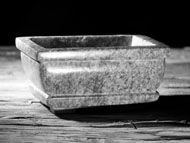
LT: And your art reflects this?
TF: Not really.
LT: How has NWSSA influenced your work as an alleged artist?
TF: NWSSA has given me access to the three T's: Tools, Technique and Talent. I’ve learned more just checking out work stations than I have ever learned anywhere else. The people and their generosity are overwhelming.
LT: Describe your art in your own terms.
TF: My terms would be stuff and junk. The term I have heard others use, that I like, is “whimsical.” I like to collaborate: in Theater with people, in Bonsai with plants, and in Sculpture with stone. Rocks are more cooperative than people or plants, but they do have their say.
LT: Is your work representational or non-representational?
TF: Yes. Both or neither. I mean the stuff that looks like stuff was meant to be like stuff, and the stuff that doesn't look really much like stuff wasn't meant to look like stuff. I try to leave it open for interpretation. I have three main themes that I do with stone. #1: My "Japanesesque lanterns." Many people interpret these as little houses with roofs. While I am making them, I often think of little guys with hats. #2: My "chimera." Many people think of them as gargoyles or monsters. As I create these I am in an abstract world were the stone has a lot to say in what it becomes; a place where the rules of the world are superseded by the desires of the stone. A world where bunnies can be evil and menacing or fanged monsters can be placid.
LT: You said you have three main themes.
TF: You are paying attention. #3: Other stuff.
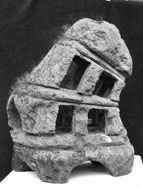
LT: How do you get your ideas?
TF: Theft, the Dollar store, fever dreams. Naps are the best. The most honest answer; I don't know. But then I also believe the first lie told to children is "Honesty is the best policy." That is almost never true.
LT: How do you develop your ideas?
TF: Direct carving mostly. I choose a stone that speaks to me. I see a spine or an emotion or movement in it and then I beat it to make it speak up. I think of making the stone open up.
LT: What is the source of inspiration of your forms, language or imagery?
TF: Imagery.
LT: Now you are deliberately misinterpreting the question.
TF: The question is vague. The source of all inspiration is the diaphragm. If you let it, a new idea or emotion will come with each passing breath: inspiration with respiration and perspiration until expiration.
LT: We might learn too much about your philosophy. So, what are you trying to express?
TF: Not sure really, haven't thought about it. Words are not the perfect communication device but they are the best thing we’ve got. I overheard a woman talking to her child. The kid was grunting and pointing in a way that was clear the little tyke wanted water. The mother encouraged her to join the adult world with the phrase "Use your words". If only more adults would use their words to get what they want. Or express how they feel. (Sings) Express yourself...dumdumdeedee...
LT: Describe a recent piece or two.
TF: I have been doing a lot of my monsters and my signature Japanesesque garden lanterns.
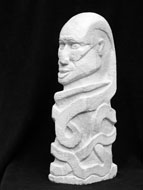
LT: What do you like about them?
TF: The monsters are fun; they seem to come to me unbidden, and I think that I am just getting good at the Japanesesque garden lanterns.
LT: What is involved in creating them?
TF: I start by tipping and turning the stone to find the base, cutting it flat and studying the rock some more. Finding flaws to remove and cutting out extra material... It’s a lot like editing.
LT: What would you say is the major theme or intent of your work?
TF: I have little intent. Local peace perhaps, world peace is too much to ask from a rock.
The theme seems to be "Let’s starve Tom."
LT: Appropriately, the next question is do you work full time as an artist?
TF: Part time, I intend to carve more, however life has gotten in the way. Health, food, shelter, bills - you know life. Stuff and junk.
LT: What stones do you prefer?
TF: I started working pumice, but I like river and field boulders for the price and the interesting forms they suggest. Natural shapes speak to me. I also like cut stone if it is of a certain proportion. But the more I pay for the rock the harder it seems to finish carving it. I love stones with a lot of interest: figures, layers, fossils. Color might be an issue, but since I’m a bit color blind, I’m not sure.
LT: What is your working process - do you work one piece at a time or do you have several going at once?
TF: I usually have several going at once; partly I hate to finish them as the stone might not be done talking to me.
LT: What tools do you use?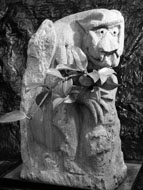
TF: Everything I've got, mostly that thing between the ears.
LT: Where do you exhibit your work?
TF: NWSSA group shows, the Kirsten, The Flower and Garden Show, North Seattle Community Collage, Lake Oswego, Westcott Bay, Jim Heltsley's show. I also have had my work on display at the Frye Art Museum.
LT: How much work do you complete in a year?
TF; Not enough! I am trying to get together a body of work to support a solo show.
LT: Do you teach art?
TF: Not really. I do give workshops on the specifics of carving pumice.
LT: Have you been influenced by any particular artist?
TF: The usual dead white guys, Hieronymus Bosch, Da Vinci, Basil Wolverton, Charles Schultz, and my favorite: Anonymous. I think he's white. Is he still working?
LT: Could be a she.
TF: Touché', I am not saying admirable Artists have to be male. I was a little flip. In fact about half of our members are women and most of them, I think, are better than me, hence the alleged artist routine.
I mean, in a group of artists, to single one of them out even for two months or whatever it is... I thank you for the recognition, but the pages devoted to my pictures and ramblings could be shared by a dozen artists. Then most of the active members could have a piece in the journal every year. I mean the thing that I like most about our symposiums is I get to see what living artists are doing today. I get to know the work of a larger group of my contemporaries. I don’t care about past figures in art, you are my influences, my inspiration. I try to do everything I can to not directly copy what wonders I see at our symposia. I try to add the tools of knowledge that I glean from everyone to my tool kit and apply them to my stones in my own way. It is hard. I am not sure if I have accomplished that.
LT: Would you like to name some of these influences?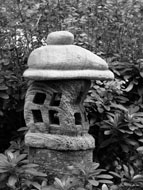
TF: No. Then they could catch me stealing.
LT: Do you have a favorite size or scale in which you like to work?
TF: I am thinking HO gauge, for the monsters; 1:1 for the garden lanterns. I tend to make things that I would want. Things I can take with me, so under 200 pounds or so. I tend to make more vertical pieces. I am limited by what I can get into my truck, but I am not really looking to go bigger. Because unless it sells I have to store it somewhere. Though I admire small figurative work, I want something with some heft. I don't know. I went insane at the last auction and bought a stone I cannot lift. It will eventually have to leave my backyard either as a large piece or several smaller pieces, time will tell.
LT: You have a backyard studio then. How is it set up?
TF: You have heard of anal retentive? Well, I am the other guy. Crap everywhere.
LT: Personal hygiene aside, what have been your satisfactions in your life as an artist?
TF: Being accused of artistry is one; referee for this year’s Pindown Girls Ladies “Wrasseling” Championships is another. Getting to do it (the artistry) is the real satisfaction. Most people just don't give it the time.
LT: What obstacles and challenges have you overcome?
TF: Does this Interview count?
LT: Not yet.
TF: I see all the obstacles as being still there: money, learning to document my work, finding an audience, the next idea, this interminable interview.
LT: What are you looking forward to? Any commissions?
TF: I am looking forward to stealing everyone’s Big Ideas. As far as commissions go, I have one to make a kind of goddess figure: Buxom. Round. Happy. Hmmm...
LT: One last Question. Anything more you want to say?
TF: I didn't want to say this much, I can’t pretend that I am smart if I don’t keep my mouth shut.

